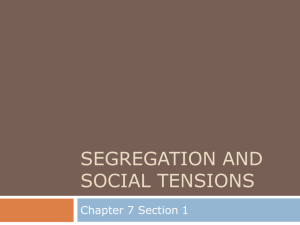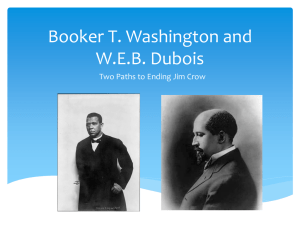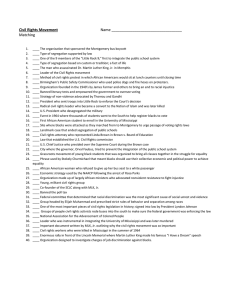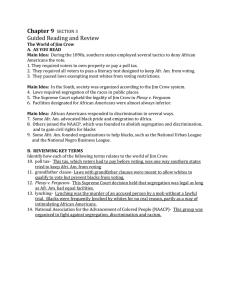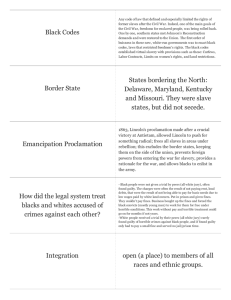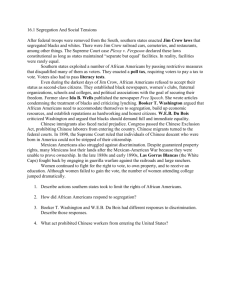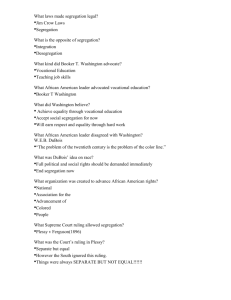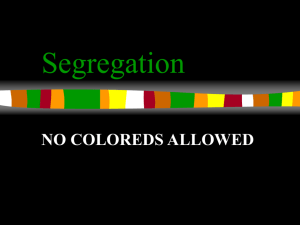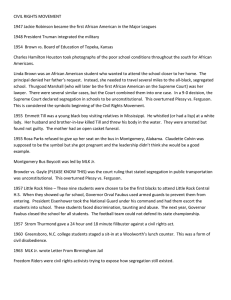Jim Crow Laws - West Ada School District
advertisement
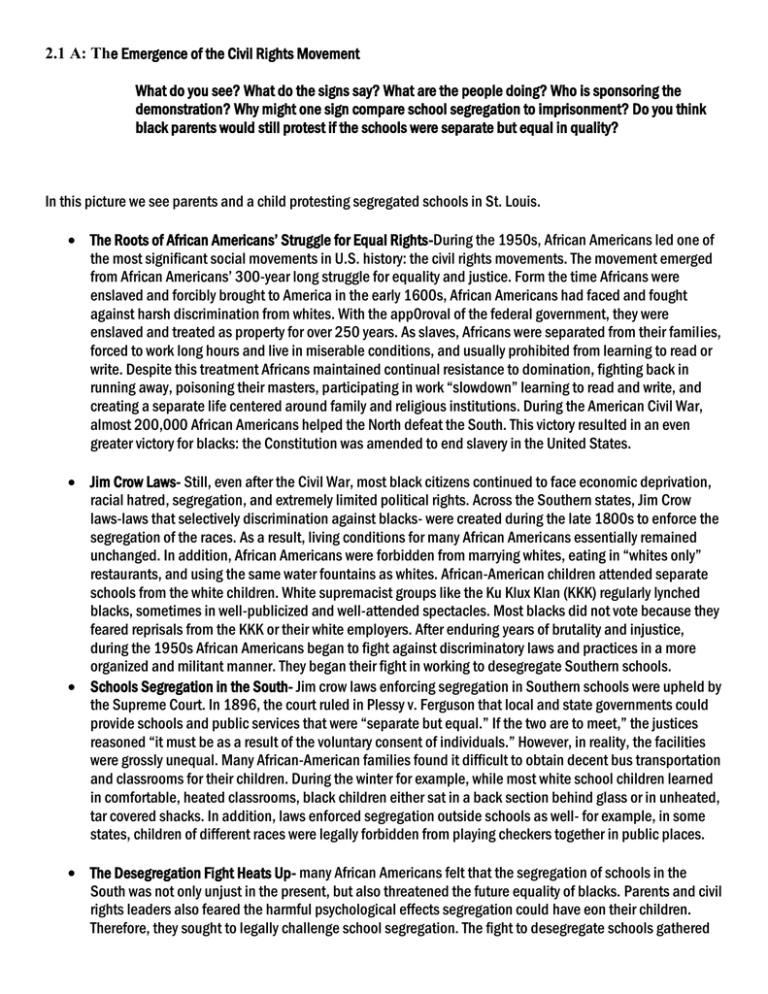
2.1 A: The Emergence of the Civil Rights Movement What do you see? What do the signs say? What are the people doing? Who is sponsoring the demonstration? Why might one sign compare school segregation to imprisonment? Do you think black parents would still protest if the schools were separate but equal in quality? In this picture we see parents and a child protesting segregated schools in St. Louis. The Roots of African Americans’ Struggle for Equal Rights-During the 1950s, African Americans led one of the most significant social movements in U.S. history: the civil rights movements. The movement emerged from African Americans’ 300-year long struggle for equality and justice. Form the time Africans were enslaved and forcibly brought to America in the early 1600s, African Americans had faced and fought against harsh discrimination from whites. With the app0roval of the federal government, they were enslaved and treated as property for over 250 years. As slaves, Africans were separated from their families, forced to work long hours and live in miserable conditions, and usually prohibited from learning to read or write. Despite this treatment Africans maintained continual resistance to domination, fighting back in running away, poisoning their masters, participating in work “slowdown” learning to read and write, and creating a separate life centered around family and religious institutions. During the American Civil War, almost 200,000 African Americans helped the North defeat the South. This victory resulted in an even greater victory for blacks: the Constitution was amended to end slavery in the United States. Jim Crow Laws- Still, even after the Civil War, most black citizens continued to face economic deprivation, racial hatred, segregation, and extremely limited political rights. Across the Southern states, Jim Crow laws-laws that selectively discrimination against blacks- were created during the late 1800s to enforce the segregation of the races. As a result, living conditions for many African Americans essentially remained unchanged. In addition, African Americans were forbidden from marrying whites, eating in “whites only” restaurants, and using the same water fountains as whites. African-American children attended separate schools from the white children. White supremacist groups like the Ku Klux Klan (KKK) regularly lynched blacks, sometimes in well-publicized and well-attended spectacles. Most blacks did not vote because they feared reprisals from the KKK or their white employers. After enduring years of brutality and injustice, during the 1950s African Americans began to fight against discriminatory laws and practices in a more organized and militant manner. They began their fight in working to desegregate Southern schools. Schools Segregation in the South- Jim crow laws enforcing segregation in Southern schools were upheld by the Supreme Court. In 1896, the court ruled in Plessy v. Ferguson that local and state governments could provide schools and public services that were “separate but equal.” If the two are to meet,” the justices reasoned “it must be as a result of the voluntary consent of individuals.” However, in reality, the facilities were grossly unequal. Many African-American families found it difficult to obtain decent bus transportation and classrooms for their children. During the winter for example, while most white school children learned in comfortable, heated classrooms, black children either sat in a back section behind glass or in unheated, tar covered shacks. In addition, laws enforced segregation outside schools as well- for example, in some states, children of different races were legally forbidden from playing checkers together in public places. The Desegregation Fight Heats Up- many African Americans felt that the segregation of schools in the South was not only unjust in the present, but also threatened the future equality of blacks. Parents and civil rights leaders also feared the harmful psychological effects segregation could have eon their children. Therefore, they sought to legally challenge school segregation. The fight to desegregate schools gathered momentum in the 1946, particularly with eh aid of Thurgood Marshall, a lawyer from the National Association for the Advancement of Colored People (NAACP). Marshall first won and important case to allow African-American Heman Sweatt attend law schools at the University of Texas. Then, he helped represent a group of four desegregation cases for primary and secondary education known collectively as Brown v. Board of Education. The cases came from Clarendon County, South Carolina, where black students had no school bus service while white students were provided 30 buses in which to ride to school; Prince Edward County, Virginia, where a 16-year-old girl named Barbara Johns led a month-long student strike against segregated classrooms; similar protest from families in Delaware and Washington DC; and Topeka, Kansas, where 7-year-old Linda Brown was denied admission to the “whites only” school six blocks from her home forced to attend the “blacks only” school many miles away. The case came before the Supreme Court in 1952, and became a landmark in the civil rights movement. Arguments for desegregation-During the trail of Brown v. Board of Education, NAACP lawyers argued that true equality could not exist where there was forced segregation. Marshall’s arguments were eloquent and straight forward, and were supported by expert social scientists who testified on behalf of desegregation. These experts said that 90 percent of social scientist believed segregation negatively affected the personality and psychology of the group experiencing prejudice, because students’ perception of reality was distorted when the democratic ideas they were taught conflicted with their reality. In response, they explained, such students often manifested feelings of frustration, inferiority, aggression, and martyrdom. Furthermore, 83 percent of researchers claimed the privileged group suffered from forced segregation as well, because they felt guilty, hardened, and confused by the conflict between the reality of inequality and the ideals of equality. Questions: 1. What are Jim Crow Laws? 2. What types of Jim Crow laws were there (list at least 3?) 3. Explain how the 1896 Plessy V. Ferguson ruling upheld segregation. 4. Who was Thurgood Marshall, and why was he so important to the movement against segregation? 5. What were the arguments against segregation in Brown v. Board of Education? 6. Why is Brown v. Board of Education such a significant court case?
